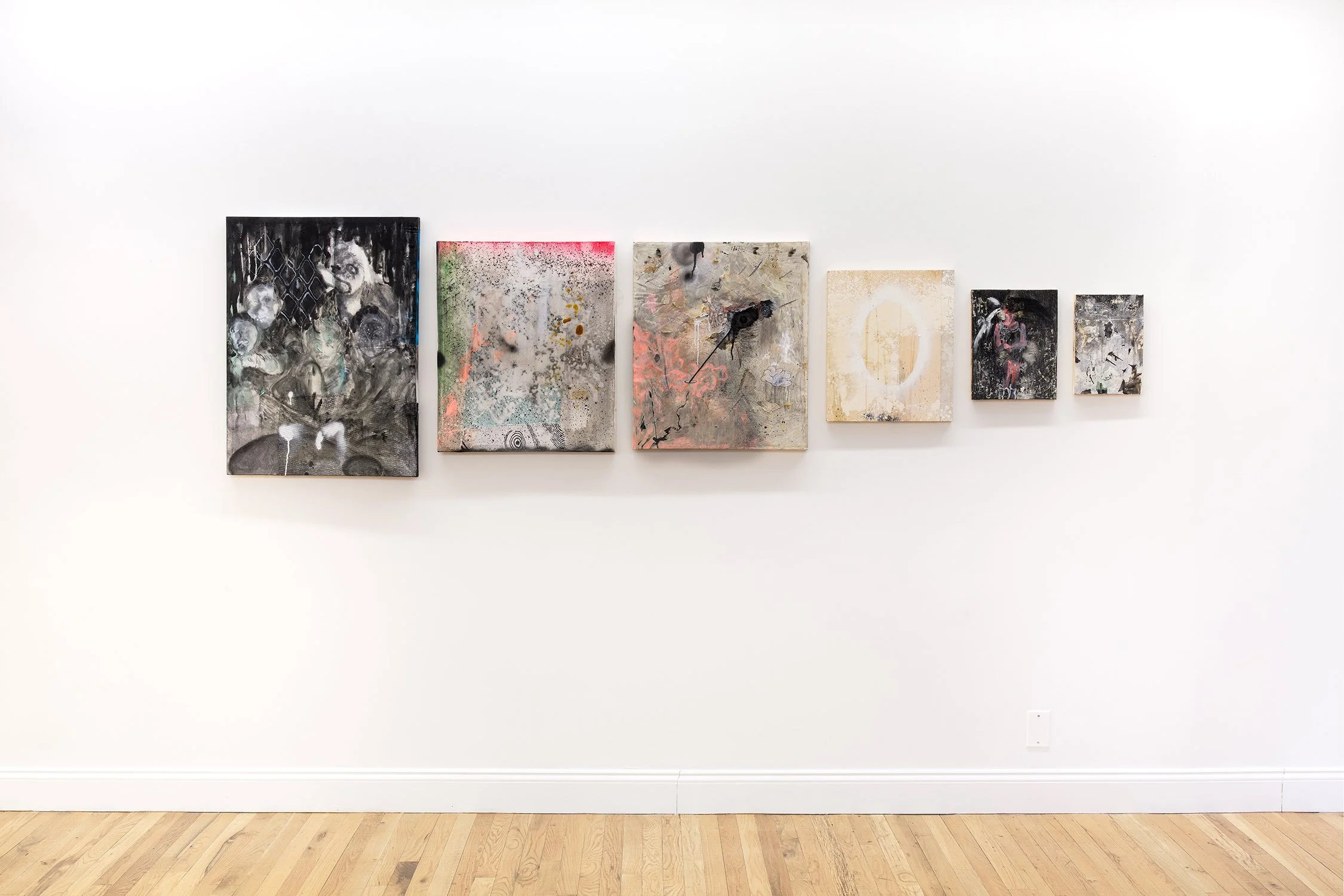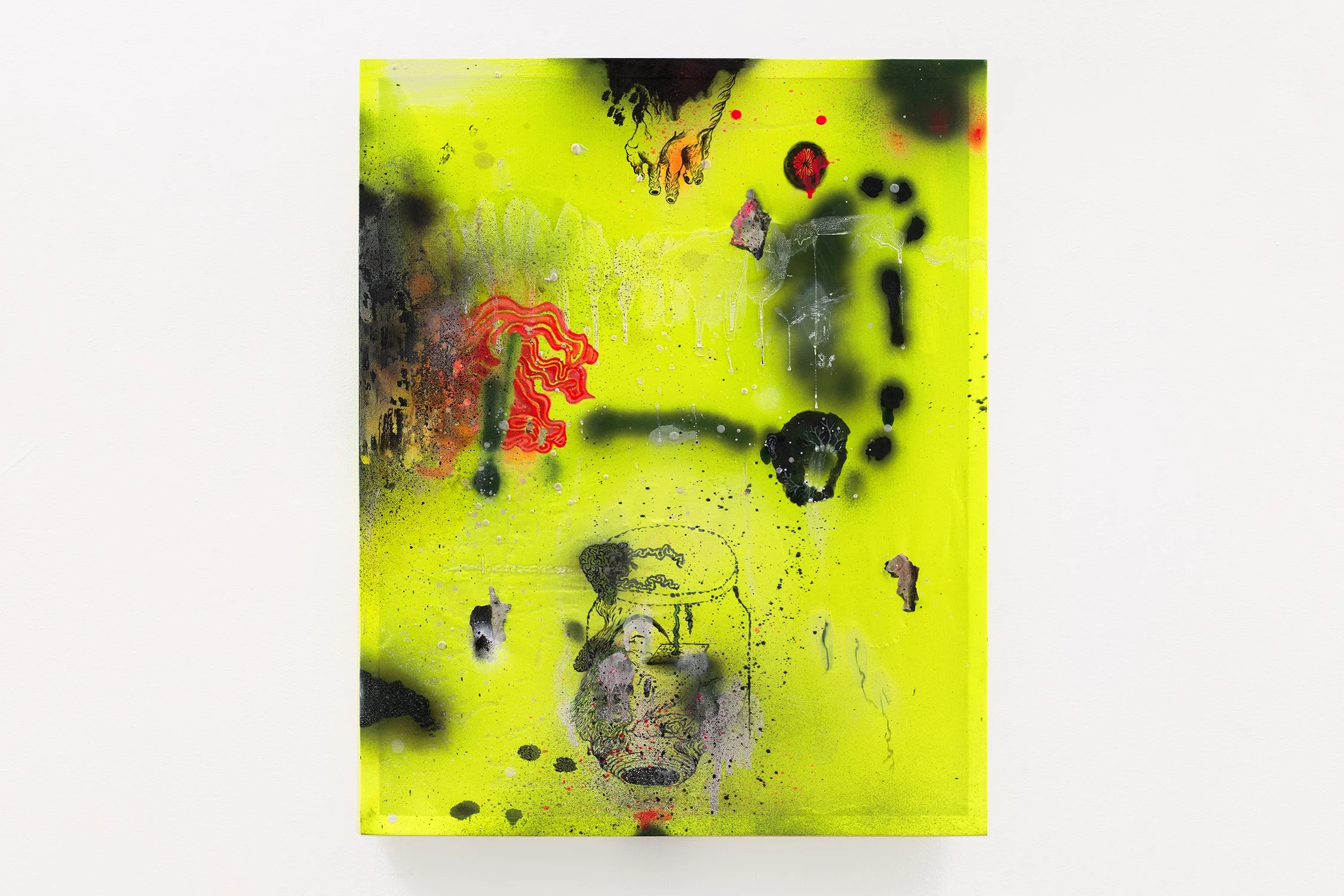Hot Coffee with Japanese artist Kosuke Kawahara, based in New York and working with Westernized aspects of contemporary Japanese culture
Kosuke Kawahara’s canvases fascinate and intrigue because of a certain quality of formal invitation.Viewer here is a spectator invited to an ambiguous, almost imperceptible performance of coalescing atomic particles and abstract, minuscule supernovas. Doris Lessing talks about society being dead when people shut off emotions in order to just keep going. Somehow Kawahara’s semi-abstract works go in the opposite direction. By looking at these amorphous structures at RAINRAIN Gallery I was reminded of intricate richness of human connection, thought exchange and ability to understand one another.
Nina: Imagine you are in your favorite coffee or tea spot. Where is it? What are you drinking? What are the three things you see right now?
Kosuke Kawahara: Drinking hot black coffee at home, on the couch.
Seeing an eight-year-old pickling bed, genital-shaped crystals, and a thousand-armed spirit.
KOSUKE KAWAHARA, Soundless Chamber, 2023-2024. Oil color, acrylic, encaustic, spray paint, ink, chalk, gesso on sutured found fabrics. 74 x 49.75 x 1.25 inches. Photo by Max Yawney, courtesy of the artist and the gallery.
Nina: Please tell me more about your ongoing solo show "Exotic Star" at RAINRAIN. What prompted this exhibition and how do the works you will be presenting fit your practice?
Kosuke: Exotic Star is an astronomical term that describes hypothetical stars deviating from the characteristics of ordinary stars, like the Sun. This title serves as a metaphor for the strangeness and irregularities in the deformation of organisms, which I have been exploring since 2018. My inspirations come from various sources, such as high radiation exposure, animal experimentations, deep-sea creatures, western and Eastern ghostly folklore, and psycho-horror movies.
These inspirations suggest that deformations can be warnings towards contemporary human activity, yet at the same time, they could be a collective challenge since the "error code" is embedded as part of the evolution of species. In future environments, we don’t know what forms we might need to survive in new circumstances.
The process of my practice is both improvisational and experimental, which synchronizes with the exploration of such themes as if groping in the dark to figure out what exists in the invisible future/past. The failure through the experimental use of materials often becomes new soil to build up fresh images, tracing the way that collectives explore the possibility of transformation through deformities.
Installation photo, KOSUKE KAWAHARA - EXOTIC STAR, February 22 - March 20, 2024. Photo by Max Yawney, courtesy of the artist and the gallery.
Nina: Could you pick one work that is currently on view and zero in on it. What is it called? What influenced your decision to choose it?
Kosuke: Forever Waiting—the largest painting in the exhibition.
The painting intuitively began with a black background, leading to the incorporation of elements from previous works depicting a carnivorous dinner and otherworldly creatures. It features ghost-like entities surrounding a barbaric dinner table set with melting heads, furry fingers, and mutated maggots. The composition of these elements came together by chance. I improvised each layer, gradually constructing the entirety—it took four years to synchronize all visual elements.
I often work late into the night at my studio, sometimes until 4 am, or even until dawn. On my way home, I encounter the neighborhood's hellish scenery, where drug abuse has escalated as a social issue since the pandemic. This landscape has infiltrated my daily life and begun to manifest in my work as part of the visual narrative. The neighborhood being named Hell’s Kitchen is merely a serendipitous coincidence.
This painting also serves as a companion piece to another large-scale work, “Take You Away,” previously presented online at RAINRAIN, which depicts malformed male genitalia. In contrast, "Forever Waiting" focuses on concavities such as mouths, vaginal openings, eyes, and anuses. To me, bodily orifices can be viewed as metaphors for portals to caves, voids, internal micro-universes, and other realms.
KOSUKE KAWAHARA, Forever Waiting, 2018 - 2023. Oil color, encaustic, spray paint, ink, pencil, gesso on wood panel. 77.75 x 62.5 x 0.75 inches. Photo by Max Yawney, courtesy of the artist and the gallery.
Nina: As a Japanese artist living and working in New York how does its singular aesthetic tradition affect your work here? Do you consciously use a technical and metaphorical toolkit acquired in Japan or have you developed an amalgamation due to your years here?
Kosuke:These days, with diversified cultural resources readily accessible through physical travel and online, the origins of distinctive aesthetics often become obscured. My background as a fourth-generation Korean-Japanese has naturally led me to blur the boundaries between nation, race, culture, and aesthetics. This complex reality, coupled with the Westernized aspects of contemporary Japanese culture, has cultivated a quiet amalgamation of diverse aesthetic influences based on personal interest.
However, despite not being religious, the philosophy of Japanese Buddhism and animism has profoundly influenced me. The acceptance of insufficiency, imperfection, and the unpredictable nature of material transformations—attributes not typically emphasized in traditional Western art—resonates with me. I view nature as an uncontrollable force, commanding respect and awe for its unpredictability and inherent violent aspects.
An additional significant influence is Japanese cuisine. My time working at a Japanese restaurant introduced me to the traditional pickling method of “Nukazuke,” involving the maintenance of a fermenting rice-bran bed for pickling vegetables. This method requires a form of nonverbal communication with bacteria, relying on scent as the key indicator for its care. This experience has been pivotal in teaching me about the aging and growth processes in a microscopic environment. It has influenced my studio practice by encouraging the development of nonverbal language within my visual art.
Installation photo, KOSUKE KAWAHARA - EXOTIC STAR, February 22 - March 20, 2024. Photo by Max Yawney, courtesy of the artist and the gallery.
Nina: Many of your works are about nonlinear distortions and mutations, passageways from one state of consciousness into another. Does this reflect our current state as a society? And if so what do you think awaits us on the other side of the passage?
Kosuke: My work, while site-specific and often reflecting the landscapes I encounter daily, transcends realistic depictions to create an alternative space between myself and the site. New York City, my home since 2011, acts as a core reference, embodying societal phenomena that manifest from the microscopic to the virtual realms. In a city filled with distortions and mutations, the question arises: Who is considered distorted, abnormal, or perverted, especially when these judgments are based on subjective perspectives?
In today's society, information overload creates chaos, making it challenging to identify what is truly essential. There is a critical need for moments and spaces where we can pause, reassess this barrage of information, and cultivate our own philosophies.
Through my art, I strive to offer a space for such reflection, recognizing that navigating these complexities requires practice. In response to what awaits us beyond this passage, I envision we develop creative solutions for our diverse circumstances through such silence. These solutions can transform our worldview, prompting a paradigm shift in society where what was once viewed negatively can be appreciated as meaningful, thought-provoking, and beautiful—much like maggots, which play a transformative role in nature.
KOSUKE KAWAHARA, New Poison, 2023-2024. Oil color, acrylic, encaustic, spray paint, ink, gesso on synthetic fabric. 31.25 x 26.25 x 1.25 inches. Photo by Max Yawney, courtesy of the artist and the gallery.





